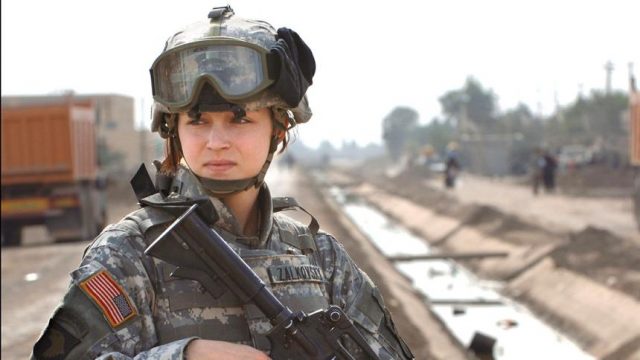Instead of Adding Women to the Draft, Why Not Just Get Rid of Selective Service?

U.S. soldier Pfc. Janelle Zalkovsky, from civil affairs unit of 1st Battalion, 320th Field Artillery Regiment, 101st Airborne Division, provides security while other soldiers survey a newly constructed road in Ibriam Jaffes, Iraq in this handout photo released on December 7, 2005. U.S. Defense Secretary Ash Carter on December 3, 2015 announced the U.S. military will open all combat jobs to women. REUTERS/U.S. Srmy/Handout FOR EDITORIAL USE ONLY. NOT FOR SALE FOR MARKETING OR ADVERTISING CAMPAIGNS. THIS IMAGE HAS BEEN SUPPLIED BY A THIRD PARTY. IT IS DISTRIBUTED, EXACTLY AS RECEIVED BY REUTERS, AS A SERVICE TO CLIENTS
Way back in 1998, on my birthday, I went down to the post office here in Minot and told the clerk working there that I wanted to register for the draft.
I did it because it’s the law. I was scared while I did it because I grew up seeing scars on my father’s body resulting from his service in Vietnam. Service to which he was legally obligated by the draft laws. My father was plucked out of Fairbanks, Alaska, and sent to the jungle to fight in what was perhaps America’s most polarizing war. He came back, to what was at the time a somewhat ungrateful nation, with a chest full of medals but also wounds both seen and unseen which are with him to this day.
[mks_pullquote align=”right” width=”300″ size=”24″ bg_color=”#ffffff” txt_color=”#000000″]“It’s my personal view,” General Robert B. Neller, commandant of the Marine Corps, told the Senate Armed Services Committee in February, “every American who’s physically qualified should register for the draft.”[/mks_pullquote]
In 6,264 days my baby boy, barring some change to the law, will also be making a trip down to the local post office (or to the Selective Service website, since that’s an option these days). Thanks to changes to federal law currently being debated in Congress – changes which have strong backing from the military itself – my two daughters may also have to register for the draft.
“It’s my personal view,” General Robert B. Neller, commandant of the Marine Corps, told the Senate Armed Services Committee in February, “every American who’s physically qualified should register for the draft.”
I would be proud of any of my children if they chose military service for themselves. I would be incensed if they were drafted and forced to serve unwillingly.
My personal issues aside, politically this puts feminists in quite the quandary. It’s one thing to demand equality with women when it comes to getting jobs and pay and promotions. It’s another thing entirely to accept equal treatment under selective service laws, which could have the federal government pulling you out of your life and sending you into some foreign meat grinder for the sake of foreign policy you may or may not support.
Men have lived with this burden for generations, but now that there’s a very real possibility women might have to carry it too, it’s amazing to see how self-described feminists contort notions of equality to justify opposition to that equal treatment.
But I have what is perhaps a better solution to the problem. Instead of treating men and women equally by putting them both at risk of forced military service, why not get rid of the draft entirely?
I’m not sure why a republic like ours, one founded upon certain notions about the consent of the governed, should be able to compel military service.
If a given conflict cannot inspire enough volunteers for military service from the American public, then perhaps it is a conflict we ought not be in.
If we’re going to have selective service laws then I suppose we must, for the sake of equal treatment under the law, include women.
But I’d rather get rid of the selective service laws.




